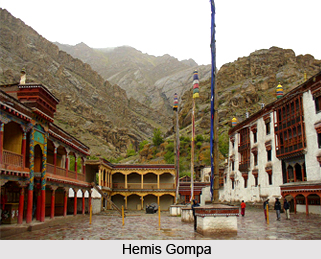 The Hemis Gompa is one of the wealthiest monasteries in Ladakh, situated in the state of Jammu and Kashmir within the Ladakh region of western Himalayas. Its unique location at an altitude of 12,000 feet makes it one of the highest settlements of the world. This monastery is the oldest one in the area belonging to the `Karagyu` school of `Brokpa` order and quite unusually holds a majority of woman inhabitants. The hilly region of Hemis holds a trenchant charm and an aura that is particular to Tibetan Buddhism in a natural and charismatic manner.
The Hemis Gompa is one of the wealthiest monasteries in Ladakh, situated in the state of Jammu and Kashmir within the Ladakh region of western Himalayas. Its unique location at an altitude of 12,000 feet makes it one of the highest settlements of the world. This monastery is the oldest one in the area belonging to the `Karagyu` school of `Brokpa` order and quite unusually holds a majority of woman inhabitants. The hilly region of Hemis holds a trenchant charm and an aura that is particular to Tibetan Buddhism in a natural and charismatic manner.
History of the Hemis Gompa
Hemis Gompa was founded 350 years ago, which was established by Lama Tagstang Raspa in 1630 and built by Palden Sara under the patronage of King Sengge Namgyal on a site previously sanctified by the construction of a cave hermitage on 12th century. The Gompa is situated inside the Hemis National Park and thus a tour to Hemis gives opportunity to tourists to enjoy the exciting wild life and beauty of nature. The Monastery is beautifully colored and decorated in Tibetan style with a huge courtyard that serves as a dance floor during the annual birth anniversary festival of Guru Padmasambhava. The mask dance in the festival is unique, highlighting Tibetan routes of culture and is a spectacular occasion to enjoy colorful break of life.
Architecture of the Hemis Gompa
The Hemis Gompa is a unique example of monastic complex in a period, which manifests geometric structure as well as religious influence in its pattern. This construction techniques and details are unique in a way that it is found nowhere else.
The main building was constructed in 1630 when `Nyingma Lhakhang` was built with a courtyard in front and a residence for the `Rinpoche` located some distance towards east. During the late seventeenth century and early eighteenth century the main Gompa building construction reached its zenith with the formation of the `Dukhang Chenmo` or large assembly hall, its adjacent building, the main entrance to the Gompa building, the large courtyard and its enclosing gallery. All these were decorated with painted stone relief. Architecturally this Monastery is unique, not only because of its location but also due to its concept and construction as a three-dimension `Mandala`. The murals on the Hemis Gompa reflects rare seventeenth century pattern and designed intrinsically with a variety of pigments and gold paint. In the monastery, among many other antique objects, there is a structure of Buddha Shakyamuni, which is really exquisite and noteworthy as embellished with valuable gems and jewelry.
Attractions of the Hemis Gompa
The "Hemis" is the most well-liked attraction for the tourist not only because of its location but for the rich festival of monastery which is held in June- July. The monastery is well known for the prosperous collection of ancient pieces made of gold, silver and copper, scared Thangkas, wall paintings and various artifacts.
Another popular destination of the Hemis Gompa is the National Park which is close to the monastery. There is the High Altitude Park which is known worldwide for its rare animal, snow leopard.



















